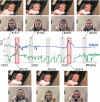IntraFace
- PMID: 27346987
- PMCID: PMC4918819
- DOI: 10.1109/FG.2015.7163082
IntraFace
Abstract
Within the last 20 years, there has been an increasing interest in the computer vision community in automated facial image analysis algorithms. This has been driven by applications in animation, market research, autonomous-driving, surveillance, and facial editing among others. To date, there exist several commercial packages for specific facial image analysis tasks such as facial expression recognition, facial attribute analysis or face tracking. However, free and easy-to-use software that incorporates all these functionalities is unavailable. This paper presents IntraFace (IF), a publicly-available software package for automated facial feature tracking, head pose estimation, facial attribute recognition, and facial expression analysis from video. In addition, IFincludes a newly develop technique for unsupervised synchrony detection to discover correlated facial behavior between two or more persons, a relatively unexplored problem in facial image analysis. In tests, IF achieved state-of-the-art results for emotion expression and action unit detection in three databases, FERA, CK+ and RU-FACS; measured audience reaction to a talk given by one of the authors; and discovered synchrony for smiling in videos of parent-infant interaction. IF is free of charge for academic use at http://www.humansensing.cs.cmu.edu/intraface/.
Figures










References
-
- Bartlett M, Littlewort G, Wu T, Movellan J. Computer expression recognition toolbox. Automatic Face & Gesture Recognition. 2008
-
- Bartlett M, Littlewort GC, Frank MG, Lainscsek C, Fasel IR, Movellan JR. Automatic recognition of facial actions in spontaneous expressions. Journal of Multimedia. 2006;1(6):22–35.
-
- Bruce V. What the human face tells the human mind: Some challenges for the robot-human interface. IEEE Int. Workshop on Robot and Human Communication. 1992
-
- Bruzzone L, Marconcini M. Domain adaptation problems: A dasvm classification technique and a circular validation strategy. PAMI. 2010;32(5):770–787. - PubMed
-
- Chang C-C, Lin C-J. LIBSVM: A library for support vector machines. ACM Transactions on Intelligent Systems and Technology. 2011;2(27):1–27. 27.
Grants and funding
LinkOut - more resources
Full Text Sources
Other Literature Sources
Research Materials
Miscellaneous
